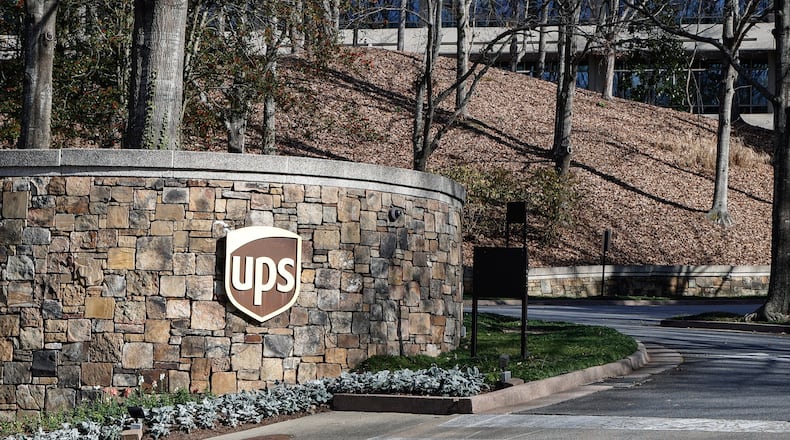News that UPS is slashing 12,000 employees — 14% of its managers — sent shock waves through the business world this week, raising questions about the strength of the economy and the Sandy Springs-based company’s strategy.
The cuts were announced Tuesday as UPS reported a $6.7 billion profit for last year, which represented a drop of about $4 billion — nearly 42% — from 2022. The layoffs will save about $1 billion in costs, the company said.
UPS signaled coming into 2023 that it would be a weaker year than 2022. Consumer spending remains strong, but UPS reported a steeper drop in revenue compared to its chief rival, FedEx. That signals that much of UPS’s financial pain has come from customers shifting to other carriers, which accelerated during fraught union negotiations last summer, and that UPS has vowed to reverse.
UPS is a barometer of the broader economy and one of metro Atlanta’s biggest employers.
Analysts and experts say the company’s challenges are largely tied to the logistics business, an industry beset by increased competition and technological change at a time that interest rates make borrowing more costly.
“This is structural,” said economist Aleksandar Tomic, associate dean for strategy, innovation and technology at Boston College. “But they are hinting that this is not just a response to smaller profits. So even if the lost business comes back, these positions would not.”
UPS faces competition among traditional shipping and delivery companies, but also from likes of Amazon, which has become both a customer and a rival.
As UPS faces off with Amazon, it must contend with higher interest rates, so investments have to produce a bigger payoff to make sense, analysts said.
“The UPS job cuts ... are part of their core strategy to improve the profitability of the business,” said John Haber, chief strategy officer at Transportation Insight, an Atlanta-based logistics management company.
While UPS has its corporate offices in metro Atlanta, it also has supervisors at locations around the world. Overall, the company has nearly 500,000 employees.
“There’s even more to come out as we have a full year benefit in 2025,” said Carol Tomé, UPS chief executive. “We’ve identified new ways of working.”
UPS will continue to “align staffing in our operations to the needs of our business,” she said.
Labor deal
Last summer, the company signed a high-profile contract with the International Brotherhood of Teamsters, avoiding what could have been a painful strike. The deal was widely praised among labor organizers as generous. The job cuts announced this week are targeted at management rather than union members.
Some of the first known cuts were announced in Maryland at a customer service center where 118 workers will be let go in March, according to the Baltimore Sun.
This week, while not putting all the blame on the contract, the company said the deal had significantly raised payroll costs.
Credit: HYOSUB SHIN / AJC
Credit: HYOSUB SHIN / AJC
Moreover, UPS said it lost business during those negotiations because some customers feared a work stoppage. After the deal was ratified, some of those customers did not return to UPS.
UPS joined a host of companies that have announced job cuts in the first weeks of 2024.
Among the companies cutting were PayPal, eBay, Microsoft, SAP, Salesforce and Wayfair. None of them have a significant union presence in their workforces.
The Teamsters did not respond to several requests for comment Wednesday.
But blaming unions is a natural outlet for companies with problems, said labor economist Harry Holzer of Georgetown University. “It’s something the company will always do. Whether that’s fair or accurate is another story.”
The key to profitability — with or without unions — is to have productive workers, he said.
The job cuts aren’t the only big workforce shift at UPS, which in recent weeks announced a plan to require white collar employees to return to offices five days a week.
Stock price slips
Job cuts are typically applauded on Wall Street, where investors see lower costs and increased profits. And prior to the announcement, UPS stock had been stumbling.
UPS stock has lost about 10% in value this week. It has fallen about 27% since cresting at a 52-week high of nearly $200 a share. UPS ended the trading day Wednesday at $141.90 a share, down $3.16 a share on the day.
Stewart Glickman, deputy research director at CFRA Research, said he continues to recommend that clients who have invested in UPS continue to hold onto their stock. He said he expects the UPS prices to rise to $154 a share within the next 12 months.
An analyst at TD Cowen wrote Wednesday that they don’t expect the stock to move much, either up or down, until the company can show its profit margins are improving.
“For now, we remain on the sidelines,” the analyst wrote.
FedEx, one of the company’s chief competitors, has also seen its stock pressured, but less dramatically. FedEx shares ended the trading day Wednesday at $241.29, down $2.48 a share, down 14.7% from its 52-week high reached in December.
Another rival, DHL has seen its stock slide about 7% from its high a few months ago. DHL shares ended the trading day Wednesday at $47.91 a share.
UPS also must compete with the U.S. Postal Service, an independent agency under control of the federal government.
Keep Reading
The Latest
Featured





